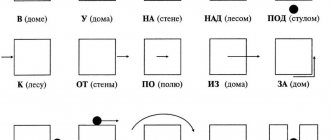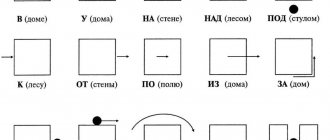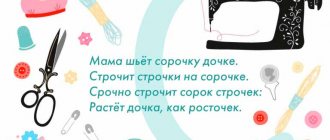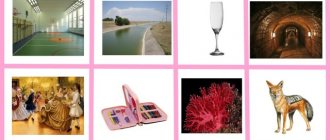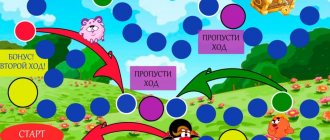Automation of the sound “R” in texts using mnemonic tracks is carried out after the sound is automated in syllables, words, phrases, sentences, and tongue twisters.
Here you can also find poems for automating the sound “R”, a game exercise “Snails”, a set of classes (the complex includes 9 full-fledged lessons with visual material).
You can recite texts and memorize poems at the same time. These two types of lessons on automating the sound “R” are final.
After them, differentiation (discrimination) of mixed sounds begins. In this case, these are the sounds “R” - “L”. They are most often mixed and confused by kids.
Games and exercises for differentiating sounds can be found at the dedicated link.
Automation of the sound P in texts using mnemonic tracks will help:
- Teach your child to pronounce the sound “R” in a coherent text, and therefore in colloquial speech.
- Using mnemonics will develop associative thinking, memory, and attention in children. They will need to match each word with a picture and name it.
- With the help of preposition models, the child will learn to see and hear this “small” word. Children very often connect prepositions with nouns and consider them to be one word (for example, a combination of words ON the table , kids perceive them as one word DESK, etc.). Models of prepositions are presented below.
- With the help of mnemonic tracks, the child will learn to correctly compose sentences and stories. This skill will also be useful in the future when studying at school, because... will teach the child to think figuratively.
Preposition models:
The texts are made in two versions to choose from:
- The first option is signed for the convenience of adults. Tex goes immediately below the picture path. It is designed for individual work with children who cannot read.
- The second version of text mnemonic tracks contains only chains of connected pictures. The pictures are larger in size. There is no signed text in the second version so as not to distract reading children. With the second option, you can work both individually and with a subgroup of children. In this case, the text of the story must be printed separately or on the reverse side.
Print the presented pictures on A4 sheets. It is advisable to laminate them, then they will serve you much longer and enjoy doing them.
Or study online on our website.
Texts for sound automation R:
At a construction site
Fedor gets up with the first roosters. Dresses quickly. Need to go to a construction site. There is tea in the thermos. But Fedor doesn’t drink it in the morning. He takes out kefir and pours in sugar. In the morning, kefir is refreshing. He puts on his jacket and goes out into the yard. Gets on a motorcycle. He starts the engine and drives to the construction site. The work morning begins.
In the garden
Roma and Tamara have a vegetable garden. In the garden beds, red tomatoes, colorful peppers, crispy cucumbers are ripening, sugar snap peas are blooming, and curly parsley is growing. Roma and Tamara are loosening the beds and fertilizing them. The harvest will be good!
In zoo
Yesterday Roma and Raya were at the zoo. There they saw many different animals and birds. Roma especially liked the tigers and panthers, and Raya especially liked the colorful zebras and giraffes. Roma and Raya asked the guide where these animals live and what they are fed at the zoo.
We fed the birds
It was bitterly cold. Vera and Ira went outside. Vera attached a piece of lard to the birch branches. The branch swayed. These were sparrows, titmice, and red-breasted bullfinches. Then the red bullfinch flew off to the side. He only eats grains and seeds. Ira ran up to the tree and scattered a handful of seeds. The birds were happy. The children fed the birds all winter!
Friend
Yegor has a friend. His name is Artyom Dronov. Egor has been friends with him since first grade. Together Egor and Artyom do homework, play football and computer games.
One day Yegor caught a cold. The doctor prescribed him to drink cough medicine. Egor was lying in bed at home, and Artyom bought the medicine at the pharmacy. All week Artem visited his friend and told him school news.
Yura and Raya
Yura has a rocket. Raya has rackets. In the morning Yura and Raya play with a rocket. Yura rules the rocket, and Raya controls the game. Then they go into the yard and play badminton with Raine's rackets. Yura and Raya love to play with each other.
Cockroach's dream
Roma has a hole in his pocket. Roma stuffs his pocket with food. The cockroach follows Roma and picks up crackers, bagels, fruits and cake crumbs. Today the cockroach will invite his friends to visit, and they will have a huge feast. A hole in a slob's pocket is every cockroach's dream
Why is it difficult to growl?
The sound "r" is considered one of the most difficult to reproduce. To pronounce it correctly, you need:
- raise the tip of the tongue to the upper teeth - while it should remain spread out, like a pancake, and not narrow from tension;
- As you exhale, direct a powerful air stream to the tip so that vibration occurs.
For such manipulations, the child needs a developed speech apparatus, a strong tongue root and frenulum. Usually all this is formed by the age of six.
What exercises can you do at home?
Establishing the exact cause of rotacism and determining how to deal with it in your particular case is a task for a speech therapist. But if the child is not yet six or due to certain circumstances it is not yet possible to visit a specialist, you can try to curb the “r” yourself. To do this, you need to fulfill only three conditions.
- Have patience. The process is unlikely to be quick and the result easy. You may need months of daily practice.
- Prepare the place. Speech therapy exercises are best performed while sitting together in front of a large mirror. The baby needs to clearly see the movements of the mouth - yours and his own. Alternatively, sit opposite each other, but then your student should have a large table mirror.
- Get ready for the game. Although mastering the “r” is a serious matter, it is better to conduct classes in a playful way. Let the child perceive them as a reason to have fun with mom or dad, and not as a difficult and boring chore. In any case, training should take no more than 10–15 minutes a day, and even then with breaks.
Now let's move on to the exercises.
Articulation gymnastics
You need to start the lesson by warming up your speech apparatus. These exercises will warm up the muscles, strengthen the tongue and help stretch the hyoid frenulum.
Swing
We open our mouth wide and swing our tongue up and down, touching the upper and lower teeth. Then we hold the tip near the upper teeth for 15–20 seconds.
Cuckoo
The mouth is still wide open. We stick out the tip of our tongue and touch it to the upper lip, and then hide it behind the upper teeth.
Painter
We imagine that the tongue is a wide brush, and carefully “paint” the teeth, cheeks, and upper palate with it.
horse
We click our tongue on the upper palate, as if a horse’s hooves are clicking.
Treat
We lick our lips clockwise and counterclockwise with our tongue outstretched.
Kitty
Imagine that there is a treat on the saucer - jam or ice cream. Now you need to stick your tongue out as far as possible and lick the treat so that the tongue does not curl into a tube, but remains spread out.
Harmonic
We lift the tongue up and “glue” its tip to the palate. Now, without lifting your tongue, open and close your mouth.
Hammer
We stretch our mouth into a smile and tap the tip of our tongue on the base of the front teeth, as if we are hammering nails.
Exercises for making the sound “r”
To pronounce “r” correctly, you need to start with other sounds.
Drum
Open your mouth wide and hit the tip of your tongue behind your upper teeth, pronouncing the sound “d.” Slowly at first, then faster. And there it’s already not far from “r”.
Buzzer
We pronounce the sound “zh” and at the same time constantly pull the tip of the tongue deep into the mouth. Over time, the “zh” will turn into a weakly vibrating “r”.
Snake
We repeat the sound “s-s-s” several times, after which we swallow our tongue and touch the tip of our tongue to the roof of our mouth.
Turkey
We stick out our wide tongue and perform movements back and forth, sliding the tip along the hard palate. At the moment when the tongue touches the alveoli - the tubercles behind the upper teeth, a single-beat “r” is produced.
Komarik
Open your mouth wide, lift your tongue up and rest it on the alveoli. And now for 10-15 seconds I buzz energetically, like a mosquito.
Motor
Place your index finger or a cotton swab under your tongue and vigorously move it back and forth, while simultaneously performing the “Mosquito” exercise.
Consolidate the result
When the sound itself is already obtained, you need to bring its pronunciation to automaticity. To do this, after articulation gymnastics, instead of positioning exercises, perform a complex to consolidate the skill.
- We pronounce the letter “r” loudly and clearly several times.
- We practice “r” through the consonant sounds “d” and “t”: “dra-dro-dru”, “tra-tro-tru”.
- We remove the supporting “d” and “t” and work with “ra-ro-ru”.
- We move on to the reverse syllables “ar-or-ur”, as well as to the position of “r” between vowels - “oru-ura-ara”. We repeat these combinations in different combinations day after day until the child is able to pronounce “r” with vibration. Only then can you practice with words.
- First, we practice words that begin with “r” or even with “tr” and “dr” (grass, firewood, throne, drone, ladder, drape, hand, river, shirt). Then we take on nouns where “p” is in the middle or at the end (cow, great, carpet, fence, axe).
- We include sentences, rhymes and tongue twisters with the letter “r”.
What prevents a child from pronouncing “r”
Hyoid frenulum (small membrane located under the tongue). By the age of six, the child’s tongue frenulum should stretch to 8 mm or more. If it is short, thick, and inactive, difficulties may arise with the sound “r”. In this case, you need to either try to stretch it with the help of special exercises, or trim it at the clinic.
Impaired sound pronunciation. A problem with earlier sounds (for example, a child confuses whistling and hissing sounds) may later result in a problem with the sound “r”. Most likely, the pronunciation of this sound will also be impaired.
If a child pronounces the sound “l” instead of the sound “r”, the situation is normal and can be easily corrected. These two sounds are similar in terms of the position of the tongue, but pronouncing “l” is easier, and the child, hearing “r” in someone else’s speech and trying to repeat it, chooses the simplest method. If a child replaces the sound “r” with other sounds, the situation is more complicated, but in this case we can say that he hears it.
If a child misses a sound or swallows, it can be assumed that phonemic perception of sound is impaired.
Phonemic hearing impairment. The hearing aid cannot perceive all speech, but only individual sounds. In this case, we are talking about a violation of phonemic hearing, which manifests itself in the form of problems with distinguishing sounds.
The peak development of phonemic hearing occurs at the age of 4-5 years. But even before this age, you can notice that the child hears differently. When pronouncing words, he makes substitutions of sounds or skips individual sounds.
Signs of phonemic hearing impairment are a serious reason to take your child to a speech therapist. The cause of impaired phonemic hearing may be damage to the central nervous system, or it may be ordinary adenoids or previous otitis media.
Tone of the articulatory apparatus (tongue, cheeks, lips). Skipping sounds may also indicate insufficient development of speech muscles. A child’s speech muscles may be either insufficiently mobile (hypotonicity) or too tense (hypertonicity). In both cases, sound pronunciation suffers.
Behavioral problems. As we have already said, mastering the sound “r” requires the greatest effort from the child. Making the “r” sound is especially difficult for children with behavioral disorders such as attention deficit hyperactivity disorder (ADHD). No less problems with learning pronunciation arise in tonically relaxed children.
Throat "r". If a child has developed according to norms, hears all sounds and the process of mastering speech has not caused him any problems, he does not have the habit of working on acquiring speech skills. In this case, when trying to reproduce the sound “r”, he can take the path of least resistance and replace the difficult to pronounce “r” with a simpler option, namely the laryngeal “r” (in this case, the vibration occurs due to the laryngeal uvula).
Correcting the “r” in the throat is very difficult, since in this case relearning is required. In this case, you definitely need to contact a speech therapist. The situation is further complicated by the fact that many parents simply cannot distinguish the “r” in the throat from the “r” in the tongue.
In all these cases, the most important thing is to correctly determine for what reason the child cannot independently cope with the sound “r”. And the best solution is to contact a speech therapist. A qualified speech therapist will check the frenulum and tone, phonemic hearing, determine the throat “r” (if it is present) and, if necessary, draw up a correction route. If correctional assistance is not needed, you can try to develop the “r” sound yourself.
When to take your child to a speech therapist
It is advisable to do this before the baby goes to school. Otherwise, a problem with the pronunciation or perception of “r” may affect your studies or communication with peers.
How long will the correction take? Everything is very individual: for some, three or four sessions with a specialist are enough, while others need months of regular training at home under the supervision of a speech therapist. In any case, in adulthood, the process of correcting speech errors will require much more time and effort than at 6–7 years old.
How to distort the letter "r"
On specialized resources Rotacism the following main variants of distortion of the sound “r”, or scientifically called rotacism, are described:
- Burr, or throaty “r”. It is not the tip of the tongue that vibrates, but the soft palate. This pronunciation is normal for French and German, but not for Russian speech.
- Lateral "r". One side of the tongue is pressed against the upper teeth, the other side hangs down, and the tip does not vibrate. The result is something similar to “rl”.
- Single-stroke "r". Instead of vibrating, the tip of the tongue hits the hard palate once, forming something like the English r.
- Nasal "r". When you exhale, the air flow does not pass through the mouth, but through the nose. In addition, the tip of the tongue is pulled back and does not participate in articulation. The phrase “Roma, open the doors!” will turn into “Ngoma, otkngoy dvengi!”
- Kuchersky "r". And again, the vibration occurs in the wrong place, namely on the lips close together. The baby makes something similar to “whoa.”
- Pararotacism, or replacement of “r” with another sound. Instead of “child” you hear “child”, “hebyonok”, “vebyonok”, “yaebyonok” or even “yebyonok”.
- Missing "r". The kid simply avoids difficulties. He says not “fish”, but “yba”, not “glad”, but “hell”, not “thunder”, but “gom”.
